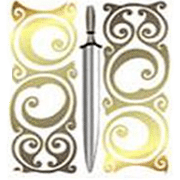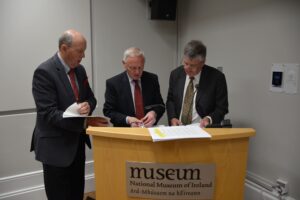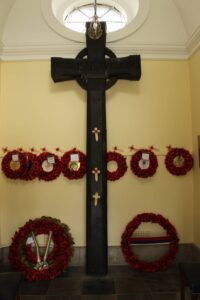On 23 April, An Post issued two new stamps to commemorate the Gallipoli landings. Designed by Dublin-based Vermillion Design, a 68c stamp shows a photograph of Irish soldiers in a trench at Gallipoli while a €1 stamp features the SS River Clyde, the landing ship which carried 2,000 of the 70,000-strong invasion force.
 A special First Day Cover envelope shows Staff Sergeant William Cosgrove from Ballinookera, Co Cork, of the 1st Battalion of the Royal Munster Fusiliers, who received the Victoria Cross for bravery during the ‘V’ Beach landings.The stamps were unveiled at Collins Barracks by the cast of PALS, an immersive First World War experience by award winning ANU Productions, which ended at Collins Barracks on 30 April. The production told the story of a group of young rugby-playing friends who made up the ill-fated 7th Battalion of The Royal Dublin Fusiliers and who underwent their initial British Army training at Collins Barracks, then named the Royal Barracks, before being deployed to Gallipoli.
A special First Day Cover envelope shows Staff Sergeant William Cosgrove from Ballinookera, Co Cork, of the 1st Battalion of the Royal Munster Fusiliers, who received the Victoria Cross for bravery during the ‘V’ Beach landings.The stamps were unveiled at Collins Barracks by the cast of PALS, an immersive First World War experience by award winning ANU Productions, which ended at Collins Barracks on 30 April. The production told the story of a group of young rugby-playing friends who made up the ill-fated 7th Battalion of The Royal Dublin Fusiliers and who underwent their initial British Army training at Collins Barracks, then named the Royal Barracks, before being deployed to Gallipoli.
Web Site
Speaking on 26 April, at the launch of a Website on the Irish Experience in the Gallipoli campaign, Minister Heather Humphreys stated inter alia “While well-remembered in the national stories of Australia, New Zealand, and Turkey, the Irish role in the Gallipoli campaign was largely forgotten over the decades. The Gallipoli campaign was followed so quickly by the 1916 Rising here at home that little focus was placed on the thousands of Irish men who were killed fighting on the front in Turkey.”
The Website is a component of the Century Ireland Website, which is produced by Boston College, in partnership with RTÉ and the Irish national cultural institutions, and is funded by the Department of the Arts, Heritage, and the Gaeltacht.
The Website will tell the story of the Gallipoli campaign from an Irish perspective. It will be updated on a daily basis over the next nine months.
This is the link; http://gallipoli.rte.ie/
Exhibition – National Museum of Ireland
The National Museum of Ireland’s major exhibition Recovered Voices – Stories of the Irish at War 1914 – 1915 continues at Collins Barracks, unveiling the complexity of the Great War and its remembrance in Ireland by showing the huge variety of ways in which Irish men and women were personally involved. About 21,000 Irishmen were already serving in the British Army when war broke out in 1914 and a further 47,000 joined in the early years of the War. The Exhibition looks at the social, economic and political reasons Irish soldiers joined the British Army and their fate – more than half of them were dead by Christmas 1914. It also looks at the Irish regiments who went to the Western Front in 1914 and to Gallipoli in 1915. See www.museum.ie for further details.
Gallipoli Campaign
100 years ago, in February – March 1915, the Allied Powers in the First World War began what became known as the Gallipoli Campaign, in order to control the sea route to Russia that was, ultimately, a disaster.
It began with a failed naval attack by British and French ships on the Dardanelles Straits. This was followed by a major land invasion of the Gallipoli Peninsula on April 25 by 70,000 men from Great Britain, Australia and New Zealand along with troops from France. This also failed, after eight months’ fighting, owing to an underestimation of the fighting ability of the Turkish army, a lack of sufficient intelligence and a complete ignorance of the terrain.
The campaign was one of the greatest Ottoman (Turkish) victories during the war and is regarded as a defining moment in the nation’s history. It is also considered the birth of national consciousness in Australia and New Zealand and the date of the landing, April 25, is known as Anzac Day.
Unfortunately, Irish battalions suffered extremely heavy losses during the “V” beach landing at Cape Helles, which was defended by entrenched Turkish machine gun posts. The main force was deployed from the SS River Clyde and included the 1st Battalion of the Royal Munster Fusiliers plus two companies of the 2nd Battalion, of the Royal Hampshire Regiment and one company of the 1st Battalion Royal Dublin Fusiliers. Another invasion attempt was made in August at Suvla Bay, but this also failed with significant losses to the 10th Division. Evacuation began in December 1915 and was completed early the following January.





